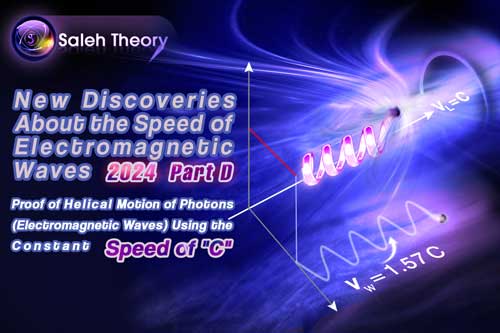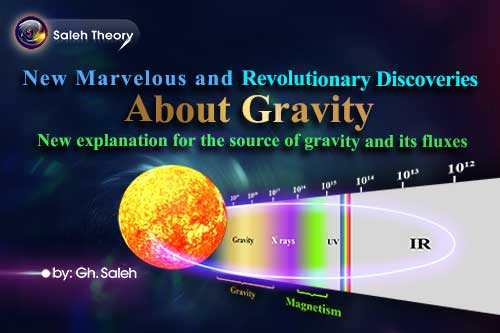
New Marvelous and Revolutionary Discoveries About Gravity
A) New explanation for the source of gravity and its fluxes
Gravity is one of the largest, most important, energetic, and influential forces in the universe. To understand its basis and nature, it is better to calculate its frequency first:
"Kinetic Energy is equal to the Gravitational Energy"
So, the relation between the energy of a planet and electromagnetic waves will be:

Where “n” is the number of force lines passing through the surface of the planet so we have:
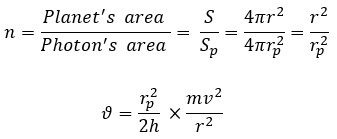
therefore:

And finally the gravitational frequency will be equal to:

Now, according to the last formula, we compute the gravitational frequency between Earth and Sun:

And the calculated amount of gravitational frequency between the Sun and the planets of the solar system should be as follows:
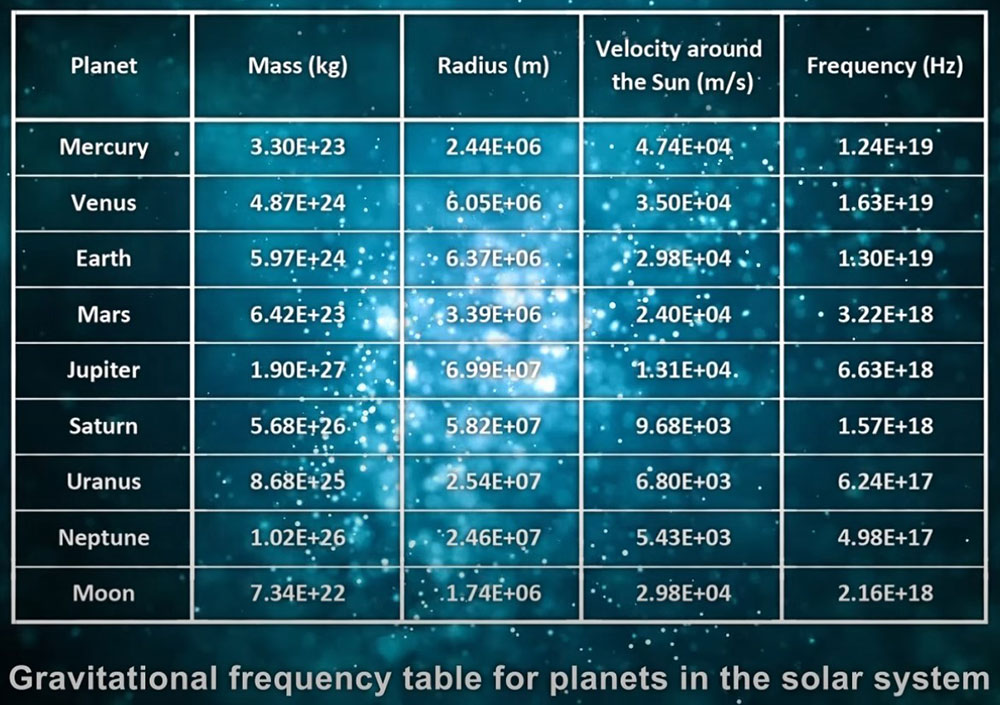
Based on the calculations and obtained frequencies for gravitational fluxes, the electromagnetic spectrum chart can be considered as follows:
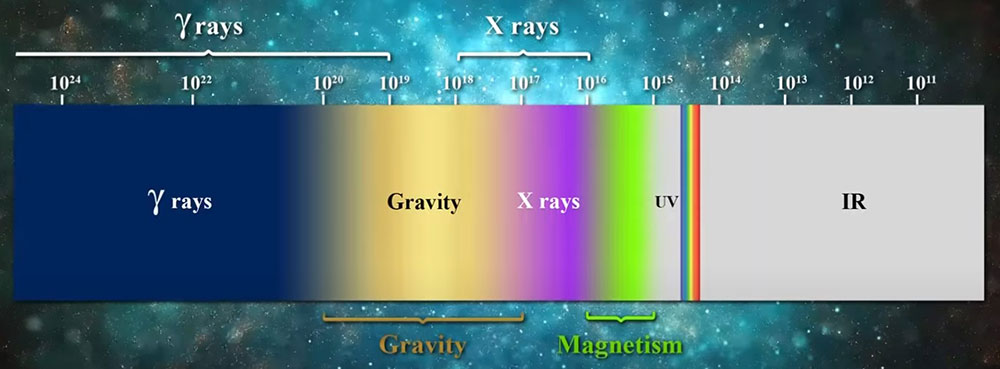
From calculations and electromagnetic spectrum charts, it can be deduced that the frequency of gravitational fluxes is lower than gamma rays and higher than X-ray waves. Therefore, it can be said that anything that is the source of X-rays and gamma rays, can also be an intrinsic source of gravitational waves. If we observe carefully, we can see that the natural sources of X-rays are very large stars, black holes, magnetars, supernova explosions, and neutron stars.
As for the source of gamma rays (which are the most powerful, dangerous, and impactful rays), they also come from magnetars, active galactic nuclei, black holes, and so on.
If we look at the electromagnetic spectrum diagram, we find that the visible light range constitutes just a small portion in the middle of the diagram. To introduce a source of radiation light, its origin must be stars. In fact, stars are the only celestial objects capable of producing visible light with high intensity and quantity. The frequency range higher than visible light belongs to the magnetic waves. Considering our solar system, apart from the Sun, which is the primary and powerful source of magnetic waves, only three planets, Earth, Jupiter, and Saturn, have the ability to generate magnetic waves but their magnetic intensity and quantities are extremely low and negligible. One can consider their power and intensity compared to the Sun as close to zero.
In the electromagnetic wave range, after the magnetic wave's range, there are X-rays. Very large stars and black holes are the sources of X-ray generation. We cannot find a planet that has the capability of producing these waves. Also, after X-rays in the diagram, we can consider gravity and gamma rays, which their sources can be just considered as stars, black holes, etc.
As a result, from the above discussions, it can be concluded that the source of gravitational fluxes is also stars, supernovae, magnetars, white dwarfs, black holes, etc. If we pay attention to the lifespan of a solar system (which includes a central star and planets orbiting around it), we find that the central star's lifespan is always about 500 million to one billion years longer than its planets. Therefore, it can be said that at first, the star is born, it grows and reaches its maturity, then the planets of that system are formed.
In other words, as a result of the created gravitational forces in the star, its planets are formed.
This is itself, evidence that stars, supernovae, magnetars, white dwarfs, black holes, etc. are the sources of gravity. In fact, if we want to find the source of all electromagnetic spectrums, it must be said that approximately 99 percent of it could be traced back to stars supernovae, magnetars, white dwarfs, black holes, and so on.
B) New explanation for the structure, model and mechanism of gravity
Visible light, emitted from our own star (the Sun), can be divided into seven distinct groups, commonly known as the seven colors of the spectrum that begins with red and ends with violet. While each color group possesses its own unique wavelength and frequency, all of these and, in general, all electromagnetic spectra fundamentally consist of photons.
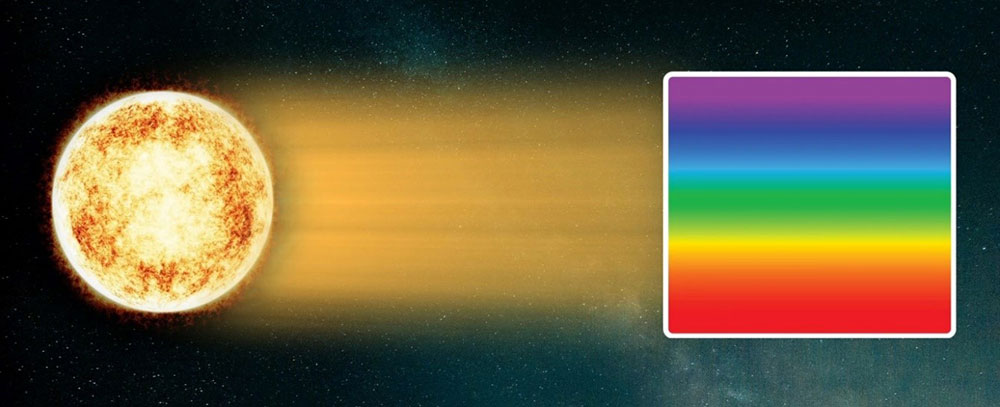
If we consider the redshift effect on the wavelength of red light, we observe a decrease in frequency, resulting in a fundamental change in its color. This redshift, occurring due to alterations in the velocity, causes the red light to shift towards the infrared region.
Although the initial red light cannot be directly observed, its underlying nature remains that of a photon. Likewise, violet light is subject to the same principle. The redshift, blueshift, high shift, and low shift phenomena can induce shifts in the frequency of violet light, leading it towards either lower or higher frequencies. Despite these frequency changes, the fundamental nature of violet light, characterized by its photon composition, remains intact.
In fact, the basis of all electromagnetic waves is a photon that has a specific wavelength and frequency. Therefore, we can conclude that the basis of all electromagnetic spectrum is the photon, each having a distinct wavelength and frequency.
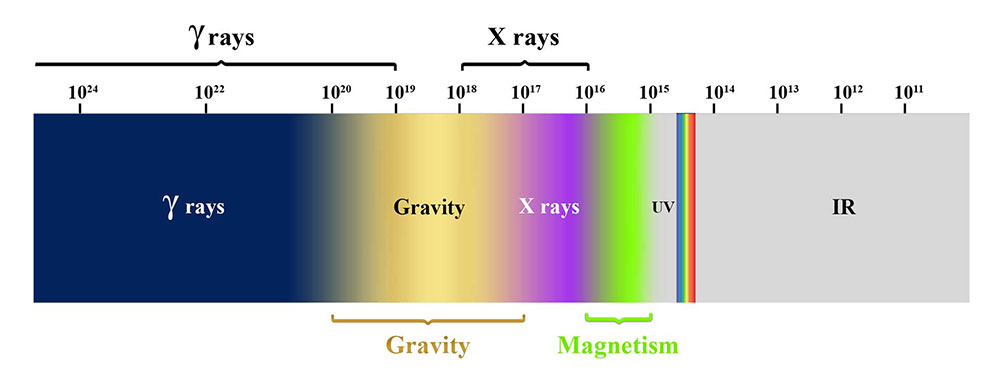
If we consider magnetic fields (which our Sun possesses and the Earth itself can weakly generate), we will observe that they are, in fact, comprised of chained photons or the same magnetic flux that travels from the North pole to the South pole and then return from the South pole to the North pole.

Based on the calculations, the magnetic frequency is approximately 1015 Hz [1], the model and structure of gravitational fluxes are similar to those of a magnetic field. Considering that the gravitational frequency is significantly higher (approximately 1000 times).
In fact, electromagnetic and gravitational waves share similarities in their generation, structure, and effect, with the main difference lying in their vastly higher frequencies for gravity waves. In other words, electromagnetic waves can be considered weak and short-range, while gravitational fluxes are strong and long-range.
C) New explanation for how fluxes are generated at the gravitational source
Given that inside stars, atomic and chemical reactions occur with high intensity, coupled with exceedingly high temperatures and pressures. Consequently, stars have the ability to emit a wide range of electromagnetic spectra that span across various ranges, including both the visible spectrum and the invisible one, such as Magnetic waves, X-rays, Gravitational waves, and Gamma rays.
Due to the high pressure and temperature present in the stars, photons become closely packed, their internal and external motions converge, and chained photons are generated. In other words, the chain of linked photons is created as the result of the high pressure and heat in the star. A bundle of these chained photons, like stretched hairs (called gravitational flux.), separate from the star, enter a planet, and return to the star, creating a cyclic rotation (like invisible belts that are big and strong).
On the other hand, stars have a rotational motion around their own axis. This stellar rotation imparts the ability for a star to regulate all of its planets in terms of their rotational velocities and other properties. Given this aspect, it can be expected a system with stable, uniform, and consistent rotation. As a sign, it should be noted that all the planets in the Solar System, even the Kuiper Belt, are situated at approximately the same level of the horizon around the Sun. Indeed, the steadfast and uniform rotation of a star around its axis will lead to the stable and uniform rotation of the planets orbiting around it.




